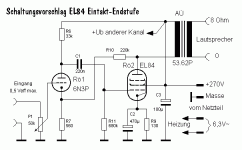Yes! It makes sense. I'm just not that used to thinking about circuits...as you might know I'm more of a cut-paste builder.Bas Horneman,
5842 lower u
lower (u + 1) x RK
lower rp
lower effective plate resistance
So more gain with the same feedback resistor (gain set by feedback loop)
12AT7 higher u
higher rp
higher (u + 1) x RK
higher effective plate resistance
less gain with the same feedback resistor (gain set by feedback loop)
yes?
no?
Chris Hornbeck,
I am not sure that I understand what you said.
For example, if the shunt feedback resistor is 100k, and it feeds back to a node that varies 1V, and if the gain at the output plate gives 100V, we have 100V + 1V, and that is 1.01mA through the 100k.
It loads the output plate with 101k, it is not 100k/gain 100. The load is not 1k.
Did I miss something?
I am not sure that I understand what you said.
For example, if the shunt feedback resistor is 100k, and it feeds back to a node that varies 1V, and if the gain at the output plate gives 100V, we have 100V + 1V, and that is 1.01mA through the 100k.
It loads the output plate with 101k, it is not 100k/gain 100. The load is not 1k.
Did I miss something?
The shunt feedback resistor works like Miller capacitance, because the anode side is actively driven, not grounded. For extreme example, like an inverting op-amp stage, the G1 side approaches zero impedance.
Or, it could be thought of as the opposite polarity of boot-strapping.
All good fortune,
Chris
Or, it could be thought of as the opposite polarity of boot-strapping.
All good fortune,
Chris
A 100k resistor that is swinging with the output tube's plate, and the other end of the 100k resistor is at a Zero node, it is still a 100k resistor.
If the plate swings 100V, and the other end of the 100k does not move, there is a change of current of 1mA.
Actually, the "zero node" has to move 1V, or the output will not move 100V (if the gain is 100).
You said the feedback resistor resistance is effectively divided by the circuit gain.
So, for a gain of 100, the 100k would effectively become 1k. That is not possible.
Perhaps I misinterpreted your statement in your Post # 19
The above is just my opinion.
If the plate swings 100V, and the other end of the 100k does not move, there is a change of current of 1mA.
Actually, the "zero node" has to move 1V, or the output will not move 100V (if the gain is 100).
You said the feedback resistor resistance is effectively divided by the circuit gain.
So, for a gain of 100, the 100k would effectively become 1k. That is not possible.
Perhaps I misinterpreted your statement in your Post # 19
The above is just my opinion.
Last edited:
Maybe think about it as currents summing to zero at a node. 100 Volts across 100K Ohms is 1mA. 1 Volt at grid supplying 1mA is effectively 1K Ohms.
For a complete derivation, see C. P. Boegli's anode follower available here:
Other Authors
All good fortune,
Chris
For a complete derivation, see C. P. Boegli's anode follower available here:
Other Authors
All good fortune,
Chris
Hi, after reading all of this, maybe we should admit that we are not so great designers and ask the source - Alex Kitic himself how it was exactly modeled in the first place.
No offence to anyone involved here!
But there is a catch, we can't ask him as He is banned from this forum permanently after vigorously defending his design and being accused of stealing it from Mr. Schade...
No offence to anyone involved here!
But there is a catch, we can't ask him as He is banned from this forum permanently after vigorously defending his design and being accused of stealing it from Mr. Schade...
Chris Hornbeck,
You are correct, the 100k looks like 1k at the Zero Node.
We were talking about different points in the circuit.
Given a gain of 100 . . .
The output stage plate 'sees' 100k. It moves 100V
The driver stage plate 'sees' 1k. It moves 1V
In both cases, both ends of the 100k current changes 1.01mA.
You were talking about the zero node.
I was talking about the output tube plate that sees the OPT primary in parallel with 100k.
The 100k does not 'become' 1k at the output tube plate.
The only plate that becomes heavily loaded is the driver plate.
And that is exactly why I do not use Schade feedback in my amplifiers, I tried it but prefer not to do that.
Yes, RH works very well, but some perfectly good designs do not appeal to me.
“In theory, there is no difference between theory and practice.
But, in practice, there is”
“Doctors and Lawyers are not perfect, they are just practicing”. . . . Me too.
You are correct, the 100k looks like 1k at the Zero Node.
We were talking about different points in the circuit.
Given a gain of 100 . . .
The output stage plate 'sees' 100k. It moves 100V
The driver stage plate 'sees' 1k. It moves 1V
In both cases, both ends of the 100k current changes 1.01mA.
You were talking about the zero node.
I was talking about the output tube plate that sees the OPT primary in parallel with 100k.
The 100k does not 'become' 1k at the output tube plate.
The only plate that becomes heavily loaded is the driver plate.
And that is exactly why I do not use Schade feedback in my amplifiers, I tried it but prefer not to do that.
Yes, RH works very well, but some perfectly good designs do not appeal to me.
“In theory, there is no difference between theory and practice.
But, in practice, there is”
“Doctors and Lawyers are not perfect, they are just practicing”. . . . Me too.
Hi, am I right saying that with this feedback the loadline of the preamp tube is no more linear, but becomes curved being partially influenced by the speaker through Rfb?
There's no issue with speaker impedance, and as always, negative voltage feedback (as long as it's negative) taken from an output improves an amplifier's performance into *any* load.
Rather, a potential issue arises with shunt feedback when the feedback is returned into the working loadline of the driving valve, especially a triode, whose distortion increases with decreasing load impedance, universally and monotonically.
It is certainly possible to graft a shunt feedback around the output valve of an otherwise conventional amplifier, but it's not trivial. The driving valve is tasked with supplying current into the fedback node in amounts much, much larger than would otherwise apply. Bringing the feedback a little further back, to the cathode of the driver valve, removes this potential issue at very small cost to stability, but isn't fashionable.
All good fortune,
Chris
Rather, a potential issue arises with shunt feedback when the feedback is returned into the working loadline of the driving valve, especially a triode, whose distortion increases with decreasing load impedance, universally and monotonically.
It is certainly possible to graft a shunt feedback around the output valve of an otherwise conventional amplifier, but it's not trivial. The driving valve is tasked with supplying current into the fedback node in amounts much, much larger than would otherwise apply. Bringing the feedback a little further back, to the cathode of the driver valve, removes this potential issue at very small cost to stability, but isn't fashionable.
All good fortune,
Chris
Yes, that's an excellent example. A type ECC83/12AX7 driver, although amazingly linear, would potentially benefit even more due to its lower Gm and perveance.
No design decisions can be made in isolation. "The knee bone's connected to the shin bone. The shin bone's connected to the ankle bone." etc. How does the chorus go? "Hear the way of the lord." or something like that. Maybe you'd have to live in the American bible belt to know the song, but it goes way deep.
All good fortune,
Chris
No design decisions can be made in isolation. "The knee bone's connected to the shin bone. The shin bone's connected to the ankle bone." etc. How does the chorus go? "Hear the way of the lord." or something like that. Maybe you'd have to live in the American bible belt to know the song, but it goes way deep.
All good fortune,
Chris
Alright, I my try it in my upcoming SEPP project - would love to hear the difference - why not - just a couple of resistors swap anyway...
Hi Chris,
I think it's been done before, something like this drawing EL84 with driver tube ecc88 or ecc85?
That's nothing new really, although it's uncommon.
Much better if isolate the input signal from returning signal using a MOSFET buffer. See the CORONA amplifier thread. This way the feedback is more effective and one can reach very low distortion with exaggerating with amount of feedback.
Corona: An Ultra-Low Distortion A2 DHT SE Amp Prototype
And this another recent example:
801A in Single-Ended A2 - Design and Build
Fashions come and go, and I'd question whether or not grafting in a semicon series differential stage falls within the thread's scope, but the value of buffering the feedback, by whatever means, is certainly controversial. It's also very difficult to see *any* advantage, but that's a different discussion.
To wander reluctantly back to the OP's question: your approach to design here might best be to find an optimum balance between the advantages of lowering output stage distortion, output transformer distortion (through lowered driving impedance), and speaker damping (maybe better thought of as immunity to impedance variations - but the same number) vs. increasing distortion and lowered slewing ability in the driver stage. You'll want to start thinking of the driver stage in power delivery terms. Not at all challenging, but different than our usual approach.
Conventional designs (meaning those that don't significantly effect loadlines) all have a longer feedback path. This can be made a liability or an asset, depending on design. But even very short feedback paths, like a cathode follower, can have stability or linearity issues if abused (and they often are). Beware of gurus.
I hope that the take-away from this discussion is that the "Rfb" needs to be treated as we would treat Cgp for Miller capacitance - input impedance (at the output valve's grid) is reduced by the factor A+1.
All good fortune,
Chris
To wander reluctantly back to the OP's question: your approach to design here might best be to find an optimum balance between the advantages of lowering output stage distortion, output transformer distortion (through lowered driving impedance), and speaker damping (maybe better thought of as immunity to impedance variations - but the same number) vs. increasing distortion and lowered slewing ability in the driver stage. You'll want to start thinking of the driver stage in power delivery terms. Not at all challenging, but different than our usual approach.
Conventional designs (meaning those that don't significantly effect loadlines) all have a longer feedback path. This can be made a liability or an asset, depending on design. But even very short feedback paths, like a cathode follower, can have stability or linearity issues if abused (and they often are). Beware of gurus.
I hope that the take-away from this discussion is that the "Rfb" needs to be treated as we would treat Cgp for Miller capacitance - input impedance (at the output valve's grid) is reduced by the factor A+1.
All good fortune,
Chris
I cannot see any controversy. The results speak for themselves. It might be difficult to see for you because you are assuming that a normal feedback loop without the buffer works as it should but it doesn't when the amount of feedback is more than few dB's.Fashions come and go, and I'd question whether or not grafting in a semicon series differential stage falls within the thread's scope, but the value of buffering the feedback, by whatever means, is certainly controversial. It's also very difficult to see *any* advantage, but that's a different discussion.
Magic has returned to the world? Perhaps this is a topic for a new thread. If you'll start one with your thesis as the beginning, we might have a topic more interesting than the usual. Thanks!
Although the weather is actually pretty nice here right now. Can't beat Spring in Arkansas. It's usually on a Thursday.
Always the best,
Chris
Although the weather is actually pretty nice here right now. Can't beat Spring in Arkansas. It's usually on a Thursday.
Always the best,
Chris
Magic has returned to the world? Perhaps this is a topic for a new thread. If you'll start one with your thesis as the beginning, we might have a topic more interesting than the usual. Thanks!
Always the best,
Chris
Well magic is the wrong word really. There are a lot of real measurements in there. Maybe you should built it and see the difference. I have already had enough dissertations in my life. Fortunately all successful but I have enough. I have just posted it. If you don't believe it, don't want to build it it's not my problem. Don't have time for the others. I have already limited time for other projects of mines.
- Home
- Amplifiers
- Tubes / Valves
- How to calculate Rfb in an RH84 amplifier


